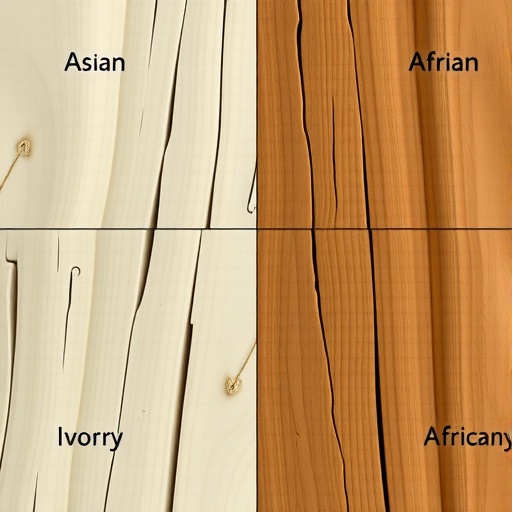In a significant breakthrough, researchers have devised a novel approach to reveal the origin of ivory, utilizing advanced techniques in Attenuated Total Reflectance Fourier Transform Infrared (ATR-FTIR) spectroscopy coupled with sophisticated chemometric analysis. This study has far-reaching implications, particularly in the conservation of elephants and the regulation of the ivory trade, which has been a longstanding issue worldwide.
The quest to distinguish between Asian and African ivory has been an ongoing challenge for scientists and conservationists alike. Traditionally, morphological characteristics and genetic analysis have been employed, but these methods are often invasive and require extensive resources. The new technique, presented by Sharma, Bhatia, and Singh, promises to alter the landscape of ivory analysis, making it less invasive while providing accurate differentiation.
ATR-FTIR spectroscopy stands out due to its ability to identify the molecular composition of materials without the need for extensive sample preparation. The integration of this technology with chemometric methods allows for a comprehensive data analysis, leading to highly reliable results. This advancement underscores the potential of spectroscopy in wildlife research, where time and resource efficiency are critical.
.adsslot_7Ejbds5JCD{ width:728px !important; height:90px !important; }
@media (max-width:1199px) { .adsslot_7Ejbds5JCD{ width:468px !important; height:60px !important; } }
@media (max-width:767px) { .adsslot_7Ejbds5JCD{ width:320px !important; height:50px !important; } }
ADVERTISEMENT
Through meticulous analyses, the research team has demonstrated that the spectral fingerprints of Asian and African ivory exhibit distinguishable characteristics. These differences are attributed to variations in the protein content and structure, which are inherently tied to the genetic makeup of the respective elephant species. This provides a pristine opportunity to gather insights into the origins of ivory, supporting both law enforcement efforts and conservation strategies.
The implications of differentiating between ivory types extend beyond laboratory confines; they possess real-world applications in wildlife management and enforcement against poaching. Armed with this new identification method, authorities can bolster their measures against illegal ivory trade by establishing the provenance of seized materials. This is vital in the ongoing efforts to protect endangered elephant populations globally.
Furthermore, the implications of this research are also significant for legal frameworks surrounding wildlife trafficking. Establishing clear identification protocols could enforce regulations more effectively, discouraging illegal transactions by ensuring that any processed ivory on the market can be traced back to its source. This could serve as a deterrent to poachers, who are deeply entrenched in the dark web of wildlife crime.
The specific focus on the chemical composition of ivory offers insights into broader applications. Understanding the variances between two prominent types of ivory not only enriches the biological discourse but also lays a foundation for further investigations into other wildlife products. It raises questions about the methodologies employed in similar studies, urging the scientific community to embrace innovative approaches in conservation biology.
In addition to the practical ramifications, the study tagged pertinent awareness to the underlying issues of wildlife conservation and biodiversity loss. By shining a light on the impacts of illegal poaching, the researchers advocate for a multifaceted approach toward wildlife preservation, incorporating scientific insights into activism and policy-making. It is crucial that scientific research is woven into the narrative of conservation efforts, illustrating the interconnectedness between data analysis and tangible action.
The research collectively advocates for the deployment of technology in addressing environmental crises. By harnessing the power of ATR-FTIR spectroscopy and chemometrics, scientists can unravel complex biological materials, thus paving the way for innovations that enhance understanding and preservation of biodiversity. Such advancements are paramount as species face unprecedented threats from habitat loss and commercial exploitation.
In conclusion, the findings from Sharma, Bhatia, and Singh’s research introduce a transformative method of ivory identification that could revamp conservation strategies globally. As awareness of endangered species escalates, the synthesis of science with strategic enforcement emerges as a beacon of hope in the fight against wildlife trafficking. This interdisciplinary approach calls for collaboration among scientists, conservationists, and policymakers to engender a sustainable future for symbolically rich species like elephants.
As this research gains traction, it is likely to stimulate discussions within the scientific community on the integration of advanced analytical techniques in environmental sciences, heralding a new era of collaborative efforts to counteract illegal wildlife trade. The ongoing evolution of such methodologies will be crucial to adapting to the ever-changing challenges in the field of conservation.
Currently, society waits to see the legislative impact of this research, and whether policy frameworks will adapt to these novel scientific insights. Ultimately, the key message is that harnessing technological advancements can provide much-needed solutions to some of the most pressing environmental issues of our time.
Subject of Research: Differentiation of Asian and African ivory using ATR-FTIR spectroscopy and chemometrics.
Article Title: Revealing ivory origin: a novel ATR-FTIR spectroscopic and chemometric approach to distinguish Asian and African variants.
Article References:
Sharma, C.P., Bhatia, D. & Singh, R. Revealing ivory origin: a novel ATR-FTIR spectroscopic and chemometric approach to distinguish Asian and African variants.
Sci Nat 112, 55 (2025). https://doi.org/10.1007/s00114-025-02005-y
Image Credits: AI Generated
DOI: https://doi.org/10.1007/s00114-025-02005-y
Keywords: Ivory, ATR-FTIR spectroscopy, Chemometrics, Conservation, Wildlife trafficking, Elephant preservation, Biodiversity loss.
Tags: advancements in ivory analysis technologyAfrican ivory identificationAsian ivory identificationATR-FTIR spectroscopy applicationschemometric analysis in wildlife researchconservation of elephantsdistinguishing ivory speciesecological implications of ivory tradeinnovative techniques in conservation scienceivory trade regulation techniquesmolecular composition analysisnon-invasive ivory testing methods





